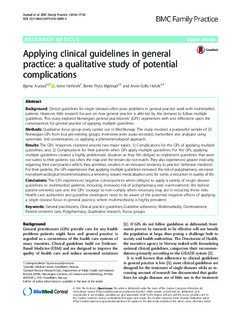Applying clinical guidelines in general practice: A qualitative study of potential complications
Journal article, Peer reviewed

Åpne
Permanent lenke
http://hdl.handle.net/11250/2432133Utgivelsesdato
2016Metadata
Vis full innførselSamlinger
Sammendrag
Background
Clinical guidelines for single diseases often pose problems in general practice work with multimorbid patients. However, little research focuses on how general practice is affected by the demand to follow multiple guidelines. This study explored Norwegian general practitioners’ (GPs’) experiences with and reflections upon the consequences for general practice of applying multiple guidelines.
Methods
Qualitative focus group study carried out in Mid-Norway. The study involved a purposeful sample of 25 Norwegian GPs from four pre-existing groups. Interviews were audio-recorded, transcribed and analyzed using systematic text condensation, i.e. applying a phenomenological approach.
Results
The GPs’ responses clustered around two major topics: 1) Complications for the GPs of applying multiple guidelines; and, 2) Complications for their patients when GPs apply multiple guidelines. For the GPs, applying multiple guidelines created a highly problematic situation as they felt obliged to implement guidelines that were not suited to their patients: too often, the map and the terrain did not match. They also experienced greater insecurity regarding their own practice which, they admitted, resulted in an increased tendency to practice ‘defensive medicine’. For their patients, the GPs experienced that applying multiple guidelines increased the risk of polypharmacy, excessive non-pharmacological recommendations, a tendency toward medicalization and, for some, a reduction in quality of life.
Conclusions
The GPs experienced negative consequences when obliged to apply a variety of single disease guidelines to multimorbid patients, including increased risk of polypharmacy and overtreatment. We believe patient-centered care and the GPs’ courage to non-comply when necessary may aid in reducing these risks. Health care authorities and guideline developers need to be aware of the potential negative effects of applying a single disease focus in general practice, where multimorbidity is highly prevalent.